A Budget Home Theater & PC Setup: 4K, HDR, UHD Blu-ray, and More
by Ganesh T S on December 26, 2017 8:30 AM ESTLocal Media Playback
Our typical HTPC testing flow involves playing back files encompassing a range of relevant codecs, containers, resolutions, and frame rates. A note of the efficiency is also made by tracking GPU usage and power consumption of the system at the wall. Over the last year or two, the focus has been on using Kodi and MPC-HC with its built-in LAV filters for benchmarking. Even though we have had non-HDR 4K clips for some time now in our test suite, we have not subject them playback at native resolution. In order to augment our test suite, we have added two files, a 4Kp25 HEVC HDR stream in a MKV container, and a 4Kp60 VP9 Profile 2 HDR stream in a WebM container.
Out of all the options we evaluated, the TCL 55P607's in-built Roku platform is the only one capable of handling Dolby Vision videos. However, when we tried to play back a sample file, the Roku interface stalled in the retrieving stage after the appearance of the Dolby Vision logo.
The TCL 55P607 Roku Media Player App - Unable to Handle Local Dolby Vision Files
Due to the absence of reliable open-source editing and decoding tools for Dolby Vision in the PC space, its testing with local media files will have to wait.
The Roku Media Player app continues to be a disappointment for users with anything other than the standard H.264 / HEVC-based camcorder files. The following recorded clip shows its failure with some interlaced MPEG-2 and H.264 clips in TS containers. VC-1 is also not supported.
On the plus side, we have automatic switching to HDR for local files which have HEVC HDR content. On the othr hand, a VP9 Profile 2 HDR clip did not generate the mode switch.
We tracked the power consumption of the TV while the Roku interface tried playing back the various files in our test suite. It was not much of a surprise to find that Roku fails to play back many of the streams. The graph segments below corresponding to the files that didn't play back are just the display remaining idle in the Roku USB Player interface.
The NVIDIA SATV supports all files in our test suite except the one encoded in VP9 Profile 2. With Kodi, we even see the HEVC HDR file being decoded and sent to the display with the appropriate mode switch.
The NVIDIA SHIELD Android TV Supports HDR Playback with Local Files
The power consumption of the SATV was tracked during the playback of each file in our test suite using Kodi 17.6. The segment corresponding to the VP9 Profile 2 file is just the duration for which the audio track was decoded and the Kodi UI remained idle.
Moving on to the PC space, we first compare the DXVAChecker outputs for the three systems. The Zotac EN1080K with its GTX 1080 GPU does not support hardware decoding of VP9 Profile 2 videos. Even if a HDR stream were to be available, the system plays back only the non-HDR versions with the desktop in HDR mode.
The Absence of VP9 10-bit Profile 2 Decoding in the GTX 1080 is the Only Odd Spot (from L to R: ASRock Beebox-S 7200U, Zotac ZBOX MAGNUS EN1080K, and the Intel NUC7i7BNHX1)
We found the native Microsoft Movies & TV app to be capable of playing back HDR videos with the desktop in HDR mode. A comparison of playback using two different players in that mode is shown below.
However, the playback of HDR files in non-HDR mode using the Microsoft Movies & TV App results in messed up colors. As such, we don't recommend the Movies & TV app for HDR file playback under all circumstances.
It is possible to use the madVR renderer in conjunction with a suitable player to shift the display to HDR mode independent of the OS setting. It is also supposed to bring the display back to the original state when exiting. We tested it out with MPC-HC and madVR v0.92.10 on the Zotac EN1080K. On the KBL-U systems, using madVR as the renderer resulted in evident dropped frames irrespective of the setting. On the Zotac EN1080K, we found that the latest NVIDIA driver release (which we absolutely had to use for Netflix 4K playback) seemed to have some issues with the restoration of the previous mode. With certain settings, the colors seemed to get crushed significantly after madVR triggered the mode change.
In fact, the only reliable combination in which we could get playback of the files in the appropriate mode was to set the OS toggle for HDR, and allow madVR to pass through the HDR metadata directly to the display (something that the madVR author specifically mentions as unsuitable for purists). We do not have automatic mode switching or even identification of HDR when using Kodi (as of v17.6). With madVR and MPC-HC, it is possible, but the consumer experience may vary.
In our opinion, HDR local media playback is yet to reach a stable state with commonly used software combinations. CyberLink's PowerDVD 17 also supports automatic HDR mode switch for playback of local files on Intel GPU-based systems. We found that it worked well in both of the KBL-U PCs, but, PowerDVD unfortunately refused to play back the VP9 Profile 2 files on those systems.
The power consumption of the three PCs during the playback of each file in our test suite using Kodi 17.6 was recorded. The same was done using the Microsoft Movies & TV app also, but, we found significant power consumption change (up to 10W at the wall) when the control overlay appeared on the screen. As such, we believe that the Microsoft Movies & TV app is not a reliable way to determine media processing efficiency of any system.
A similar graph for the madVR playback case in the Zotac ZBOX EN1080K (with OS HDR toggle set and madVR configured for HDR passthrough in full screen windowed mode) is presented below.
The power consumption numbers were also graphed for the PowerDVD playback case using the two KBL-U systems.
In general, we find that the Zotac system consumes a lot of power, but, it also performs a lot better compared to the KBL-U systems when advanced HTPC requirements like madVR rendering are considered. The HDR ecosystem is just getting started and we are waiting for things to reach a more matured state before doing a detailed analysis of the playback of local HDR files in PCs.


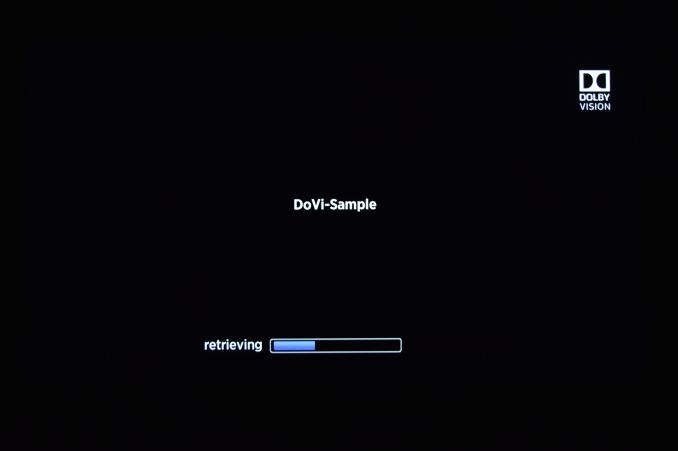

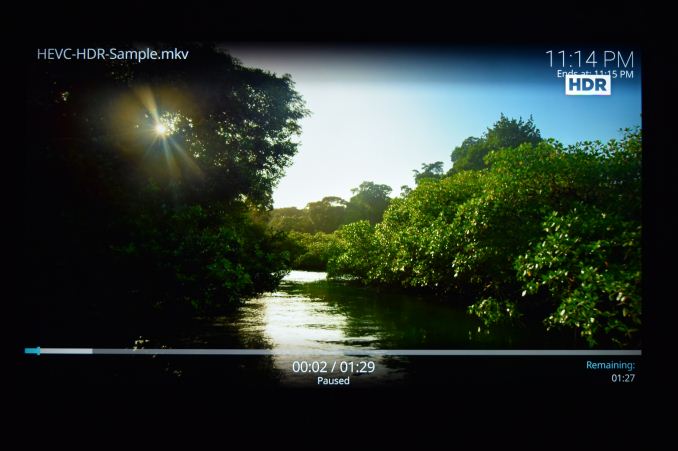
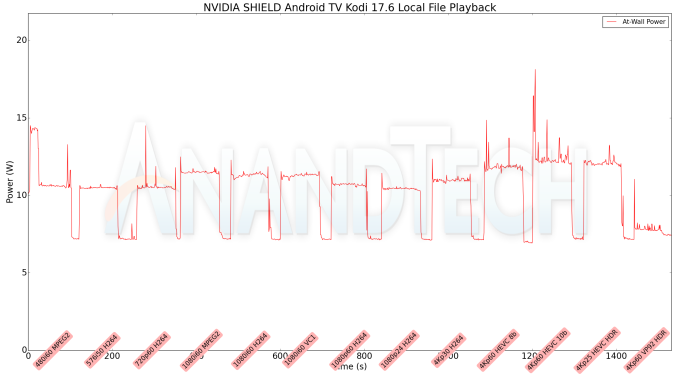
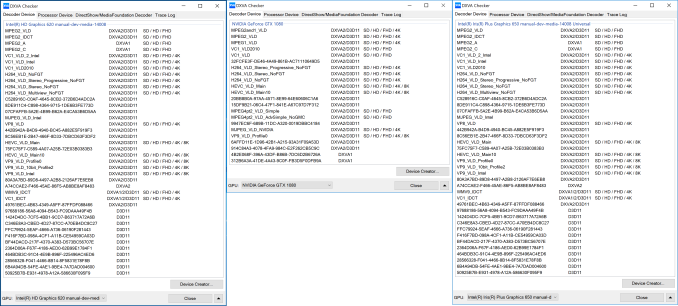
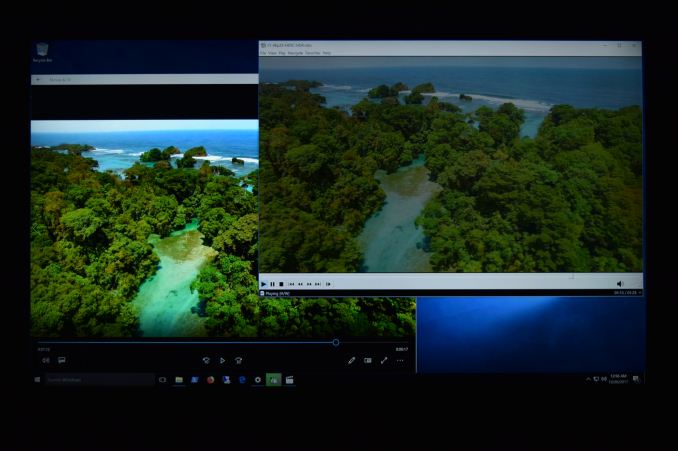
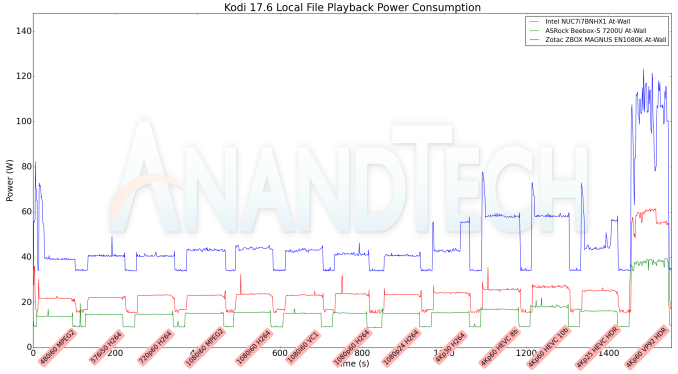










191 Comments
View All Comments
pjcamp - Wednesday, December 27, 2017 - link
The one thing you didn't mention is what keyboard you are using. I haven't been happy with any of the ones I've used so a little help would be, well, helpful.DIE_BETA_SOY_BOYS - Wednesday, December 27, 2017 - link
"budget"What a useless article
watersb - Wednesday, December 27, 2017 - link
I, for one, enjoyed this write-up very much. I have been out of the AV Zone for a decade, but as a musician and PC enthusiast I was curious to see how this played out.A write-up like this: I have done similar tests for audio-only gear, and it took 50 hours of work. Maybe I'm too slow.
And finally, this may be a dumb question, but for a Home Theater setup, what keyboard/pointing device work best for you? I need to get something. My ten-year-old Gyration Mouse/keyboard has died. Not kidding. It was great. Backlit keyboard that can see duty as primary PC keyboard preferred.
What are you all using?
Shaan1969 - Thursday, December 28, 2017 - link
watersb, Logitech K830 (~$50) is the best one with long lasting rechargeable battery with back-lit option. I have been using it for the last few years without any issues.watersb - Tuesday, January 2, 2018 - link
Thanks! Was on my list, at $50 the price has come down a bit since last I looked.Shaan1969 - Thursday, December 28, 2017 - link
Ganesh, thank you for taking time to write up a great article. I thoroughly enjoyed reading it and planning to upgrade my HTPC accordingly this weekend.Everyone's definition of budget is different and I wish readers focus on the content of the article rather than accusing the writer.
milkod2001 - Thursday, December 28, 2017 - link
good read, you might want to also upgrade those curtains granny bought and insisted to use when on last visit while you are in this upgrading process.UtilityMax - Friday, December 29, 2017 - link
This situation with the high cost and pain-in-the-butt involved in 4K HTPC setup compared to buying Playstation 4, Xbox, or Roku reminds me of a similar situation that happened with home routers in the late 1990s. As the Internet connections started becoming more affordable (be it dialup or broadband) a whole lot of geeks wanted to come up with solutions so that their entire home network could connect to the internet with just one IP address. A whole lot of them turned to setting up a dedicated PC running Linux to act as their gateway to the internet for the purpose of firewalling and network address translation (NAT). This made even people originally not interested in using Linux start exploring the Linux systems because back in the 1990s Linux distributions were way better than Windows or Macs at advanced networking stuff.Then an interesting thing happened. A cheap Taiwanese-made router with firewall, NAT, and a 4-5 port 100Mbps switch became available for something like 50 bucks around year 1999-2000. This has near instantly killed the concept of setting up manually a dedicated PC to act as your router gateway. Today you don't even have to buy a dedicated router, because your broadband cable modem probably already comes integrated with wifi, router, NAT, firewall, switch, and all that (mine does).
The same way we are observing the situation where various set top boxes or "sticks" costing under a couple of hundred bucks, gaming consoles, and even smart TVs have pretty much near eliminated the whole point of building a dedicated HTPC. HTPC is basically a dinosaur.
Combine that with the fact that most people out there still don't give a damn about 4K content, don't have 4K TVs, don't have access to 4K cable (duh!), and don't want to pay for either 4K BD discs or for high speed internet conections required for 4K streaming, and you see why building your own HTPC is going to be just like banging your head against a wall.
rapster - Friday, December 29, 2017 - link
Totally agree. The NVIDIA Shield has - for me - made the PC moot. This time around I based my system on a Shield that streams from the internet and Synology disk array, a “budget” receiver, a BD player, some great speakers, and an old 1080p TV. Not even sure what use a PC would serve.mikato - Thursday, January 18, 2018 - link
Sounds good. I’ll have to check out the Shield. But you can’t bring this to a friend’s house and plug into their TV or home theater. I want that too :)